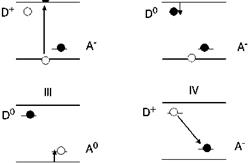This luminescence mechanism is found in some semi-conducting materials that are doped with both donors and acceptors. The mechanism is depicted in Figure 5.50, in which step IV results in luminescence. Ionized donors, the resulting holes in the valence band caused by ionized acceptors, capture electrons that are excited into the conduction band. The emission involves electron transfer between neutral donors and neutral acceptors. The final state (with ionized donors and acceptors) is Coulomb stabilized. Therefore, the spectral position of the emission generated on a donor-acceptor pair depends on the distance between the donor and the acceptor in a pair: the smaller the distance, the higher the energy of the photon generated. In the phosphor crystal lattice, many different donor-acceptor distances are possible, leading to a relatively broad emission band. This mechanism is operative in the blue and green emitting phosphors, which are used in color television picture tubes (ZnS:Ag, Cl and ZnS:Cu, Au, Al, respectively).
II
 Fig. 5.50 Processes leading to donor- acceptor pair luminescence.
Fig. 5.50 Processes leading to donor- acceptor pair luminescence.
5.5.3.4
 20 января, 2016
20 января, 2016  Pokraskin
Pokraskin  Опубликовано в рубрике
Опубликовано в рубрике 